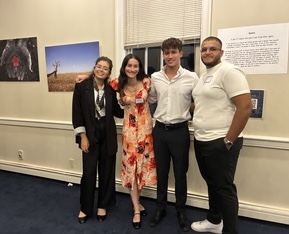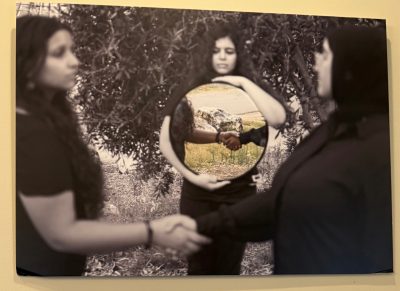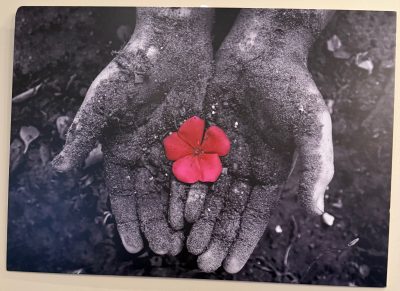Israeli Jewish and Arab Teens Share Photography, Vision of Coexistence at Chappaqua Performing Arts Center
News Based on facts, either observed and verified directly by the reporter, or reported and verified from knowledgeable sources.

By Idan Yedid, Horace Greeley High School senior
When Yali, a Jewish-Israeli teenager, entered the program Through Others’ Eyes (TOE) to learn photography alongside Arab teens, he had some doubts about meeting the other side. The feeling was mutual.
But even in the context of a painful, ongoing war, these Jewish and Arab teens grew close and became friends. As they bonded, their photography skills blossomed into final projects that, together, formed a powerful exhibit.
On Thursday night, the Chappaqua Performing Arts Center bustled with conversation as more than 200 community members viewed the exhibit. Yali and three of his Jewish and Arab peers watched as people poured into the center to experience their work and hear their stories.
“I came in with stereotypes about the other side,” Yali admitted. “When I met them in person,” he continued, “it was like a shift of my opinions, my stereotypes. I realized they are humans like I am; we are actually very similar.”
TOE is associated with Givat Haviva, a school in northern Israel. It’s one of the few Israeli schools where Jews and Arabs learn together, fully integrated in one environment. TOE’s curator, Jenan Halabi—a Druze Muslim woman and skilled photographer herself—was at the event with the teens, her students.
“Photography allows teenagers to connect because it gives them a shared language beyond words,” Halabi explained. “When they look at each other’s photos, they don’t just see an image, they see a story, a perspective, a piece of someone’s life.”
Over a dozen photographs decorated the walls of the exhibit, including three by Noor, one of the two Arab teens. “I wanted to show the idea of hope,” she said, pointing to her photograph. “The red flower symbolizes beauty in the dark. I wanted to make the person understand the feeling without explaining it.”

Shir, another Jewish teen and Noor’s close friend, had a similar thought process. “It was taken in darkness, just after the war started,” Shir said of her photograph. “I wanted to show how the reality is really dark, but our vision is possible—our vision of peace.”

Forming Friendships
Spectators carefully explored the exhibit, admiring the photographs and reading their attached quotations. Next to Noor’s photograph lay a quote from the late Mahmoud Darwish, an acclaimed Palestinian poet: “We have on this land that which makes life worth living.”

Westchester resident Pamela Faith Lerman and her husband, Bob Gluck, have been organizing this event since 2022. One of her goals in bringing TOE to Westchester was “for people to be able to understand that it is indeed possible to learn to not only know people with different religions, culture and experiences, but to become friends with them.”
The planning process was not easy and faced a major setback on Oct. 7, 2023, when the terror attacks in Israel struck. Lerman had been scheduled to meet with the Shaliach of Westchester (an Israeli emissary) on Oct. 9, 2023. “Of course, that meeting did not happen,” she said. The event took almost another two years to come to fruition.
Givat Haviva’s bridge-building programs were also impacted, including TOE. According to Halabi, when Givat Haviva resumed programming, leaders initially kept Jewish and Arab teens apart before reuniting them. TOE was the exception, the only program that kept participants together from the start.
Now in Chappaqua, the teens from Israel got to meet local Westchester teens, enjoying pizza, ice cream, and a round of icebreakers. Then, everyone moved to the theater for a Q&A session with the teens and Halabi.
The crowd was highly curious and engaged, asking a variety of questions and repeatedly breaking into thunderous applause.
Hopefulness
When asked how the war impacted the teens’ relationships with one another, Yali said it allowed him to understand the Arab teens’ perspectives in a much deeper way. “I know the other side much better,” he said.
“At first, we were mad,” Shir added. “But after a few weeks we understood we have a responsibility to the future of Israel. Jews will stay and Arabs will stay. We have to find a way to talk.”

Similarly, Noor was initially hesitant about the program, but she ended up gaining hope and powerful friendships.
Another main point of discussion was how the teens’ families reacted to their participation in TOE. The teens said they received a lot of support from their families, especially as they learned more about the program. However, the climate in Israel is not always so encouraging.
Yali shared that some of his friends thought he was crazy. Shir recounted explaining TOE to some of her prejudiced friends and actually managed to change their minds about Arabs. In a conflict where dehumanization persists on both sides, programs like TOE are crucial.
“Why wait for the change when you can be the change?” asked Sami, an Arab teen, of the audience. “I’m telling my Arab community friends about it. They’re very excited about what I’m doing here, so [TOE] is expanding its influence.”
“One photo is worth a thousand words,” Shir remarked—a truly fitting expression. “It’s a way to express ourselves, what we experience and feel.”
As we near two years of brutal war, it’s hard to see past the human suffering and despair. But meeting teens like these generates hope for the possibility of a peaceful future.
Idan Yedid is president of Teens for Peace in the Middle East, a student-led organization connecting Israeli and Palestinian youth through peacebuilding.

Examiner Media – Keeping you informed with professionally-reported local news, features, and sports coverage.
